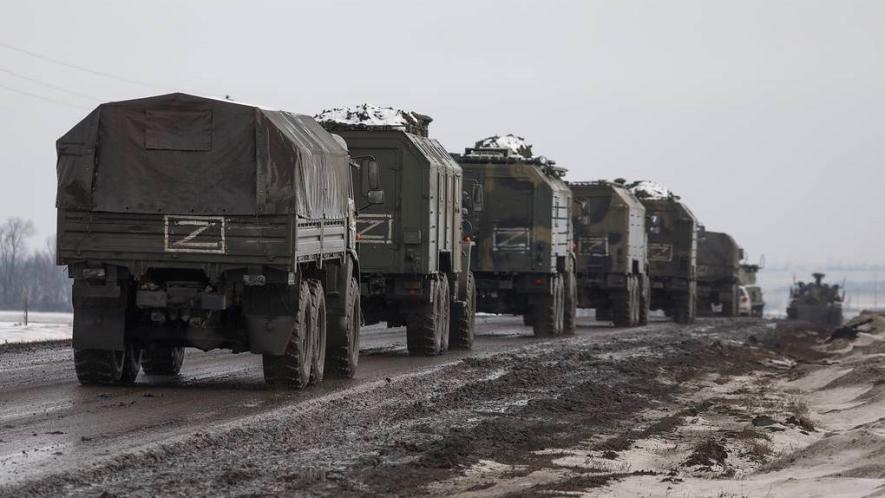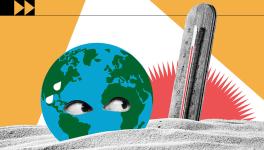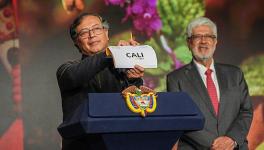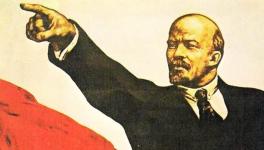Societies Can Prevent Wars From Starting—and Future of Humanity Requires Peace

(Photo- Anton Vergun/TASS)
Humanity’s future existence hinges on cooperation on a global scale. The greatest existential threats we face are worldwide problems that stem from the man-made climate disaster—and the massive decline in biodiversity, pollution, worsening storms, fires and sea level rise that come with it. Even the COVID-19 pandemic potentially resulted from deforestation and dwindling biodiversity on the planet, and the lack of action to slow down such destruction will only increase the likelihood of pandemics in the future.
The inevitable worldwide impacts of the climate crisis make the idea of war—for instance, Russian President Vladimir Putin’s aggressions in Ukraine—feel particularly irrational and anachronistic. At a time when scientists around the globe agree that the future of life for our species will require immediate worldwide actions to restore the planet, an aggressive invasion of a smaller nation by a large world power like Russia (and whispers of the unthinkable, like a third world war or nuclear violence) is recklessly out of context with the realistic priorities of our times. Large-scale war stands in stark contrast with the one thing the world should be giving critical consideration to presently: cooperation.
Research by peace and conflict studies professors at the University of North Carolina at Greensboro, anthropologists Geneviève Souillac and Douglas P. Fry (who are married), has the potential to support the sort of large-scale cooperation and peace our world so desperately needs. The two co-uthored a study published in the journal Nature in 2021 that theorises how humanity can realistically stop war: develop peace systems. Peace systems, defined as existing clusters of neighbouring societies that do not make war with each other, already exist around the world, on both small and large scales.
The study, “Societies Within Peace Systems Avoid War and Build Positive Intergroup Relationships,” assessed real-world examples of how war is stopped and future war is prevented when societies shift their cultures and values and adopt intentional systems of peace. Fry spoke with the Independent Media Institute in detail about the study in a 2021 article, “How Humanity Can Realistically Prevent New Wars From Ever Happening Again.”
Thus far, the researchers have found approximately 16 examples of peace systems and are further working to determine whether or not other societies in the world can be classified as peace systems.
“Our overall definition of a peace system is clusters of neighbouring societies that don’t make war with each other, and sometimes these societies don’t make war at all, but sometimes they do make war outside the system,” Fry says. “They [the neighbouring societies] have a history of not warring with each other.”
The peace systems that already exist today are found both in smaller Indigenous groups like Brazil’s Upper Xingu River Basin tribes and the Aboriginal Australians of the Great Western Desert, as well as in larger societies—the most obvious modern example being the European Union (EU). The EU is an example of a peace system that would have seemed impossible, even ridiculous, just decades prior to its adoption (since Europeans had historically warred with each other for hundreds of years), and it faces a critical moment of reckoning given the current events in Ukraine.
Researchers Souillac and Fry recently collaborated on the eight-minute short film “A Path Away From War,” which explains how peace systems work around the world—from how and why they are created to how they are upheld. They teamed up with Chris and Dawn Agnos of the storytelling non-profit Sustainable Human to create the film, which was released in February 2022.
The film discusses the shared characteristics that are found across peace systems, which include:
- An overarching common social identity
- Positive social interconnectedness
- Interdependence
- Non-warring values and norms
- Non-warring myths, rituals and symbols
- Peace leadership
“Most citizens of the European Union, which was created to prevent wars, now hold an overarching identity as Europeans in addition to local and national identities,” the film’s narration states. Another example woven throughout the film is that of a historic peace system created by the Indigenous peoples of North America, in which the long-warring cultures of the Cayuga, Mohawk, Seneca, Oneida and Onondaga all came together “into a union of cooperating neighbors” known as the Haudenosaunee. They intentionally formed a cooperative and peaceful society, which lasted for 300 years, until it was disrupted by the arrival of European colonial settlers.
“Many people think there has always been war and there always will be war,” the film’s narration, done by Fry, states, before pointing out that this is not the case. The film suggests that alternatives to war are necessary to tackle the existential threats all people face. It discusses the potential of peace systems to “help usher in an era of unsurpassed global cooperation” and explores the ways in which “our destinies are intertwined” around the world due to the global realities of climate change, the potential for continued outbreaks of global pandemics and nuclear proliferation.
Souillac and Fry spoke with April M. Short of the Independent Media Institute about the film and the imperative of peace systems, especially given the rising global tensions due to Russia’s war in Ukraine.
April M. Short: Though it was created prior to the Russian Federation invading Ukraine, this video, “A Path Away From War,” is especially relevant now, as the new reality of war in Europe highlights preexisting conflicts around the world, in Yemen, Ethiopia, Mali, Syria, Palestine and elsewhere. What are your thoughts on Putin’s invasion of Ukraine, and how peace systems could play into what’s happening in Europe now?
Geneviève Souillac: Peace systems are based on equality between each of the states within the peace system, and they support democratic growth—because democracy is never static, but is, rather, an evolving system.
A couple of days before the invasion occurred, a group of Ukrainian protesters held up signs in front of the Russian Embassy in Kyiv that said, “We choose Europe not Russia.” The sign expressed a choice, on the part of those Ukrainians, of a peace system over a nation behaving, to their eyes, like an empire capable of waging a war of expansion against its neighbor for its own gains.
It was a statement that was counter-empire, and it was also pro-democracy in a values-based sense. We know that another small neighbouring country, Georgia, was invaded by Russia in 2008. Its current government has expressed a wish for Georgia to join the European Union. A significant proportion of Ukrainians have had aspirations to be integrated into the EU, and the Ukrainian parliament has approved an agreement with the EU [regarding this].
AMS: You’ve both been studying peace and peace systems for years, and the Nature article containing your research about peace systems received widespread global attention after it came out in 2021. A year later, you’ve created this short film about peace systems—what inspired you?
Douglas P. Fry: We think the concept of peace systems is, on the one hand, an innovative way of looking at how to create peace and how to maintain peace. On the other hand, it has such important real-world applications that we wanted to try to get the message out there about peace systems existing, and their potential to create additional peace systems and to create peace more generally.
It happened that through a colleague we came across a filmmaking company, Sustainable Human, which focuses on peace and sustainability and addressing the human potential for enhanced well-being. Our orientation aligned nicely with this so we made contact and they were eager to make this film with us. It’s really been a joint project between Geneviève [Souillac] and myself as the academics and content leaders, with Chris and Dawn Agnos at Sustainable Human, who are very skilled at making videos.
AMS: The video makes it clear that our destinies are intertwined on a global scale. I think many people today see peace and worldwide cooperation as necessary. The video spoke to that point, and for many this current revving up toward war feels like a distraction, when we’re already faced with the larger global predicaments of the climate crisis, the pandemic and so on.
DPF: I’m sure I’m not the only one who, while watching the leader of a large and very powerful nation invade a smaller neighbouring nation, sees history repeating itself. The vital difference is that now, with Russia being a nuclear nation, the potential exists for absolute catastrophe. Putin’s invasion of Ukraine has put the possibility of collective nuclear annihilation back on the table. It’s insane.
You can listen to the mainstream media and hear all sorts of points of view about this, but one way or another the idea that nuclear war could break out due to an accident or the intentions of an authoritarian leader is very scary. I think this situation puts nuclear awareness back on the table, and I glean some positivity from that. Those of us who would like a more peaceful world empathise, and we’re terribly distressed with the tragedies we’re both seeing and not seeing—but maybe we can take solace in the idea that this particular event could actually help to crystallise a peace movement, or a peace systems movement to provide true security for everyone on the planet. There is no place for nuclear weapons if humanity is going to have a future. Sooner or later, something will go horribly wrong.
GS: It seemed anachronistic when we started seeing this invasion, and when it quickly escalated. This level of aggression, violence and destruction by one superpowerful state against a smaller nation seems so out of context, given the advances made by the international legal, economic and security system overall after World War II. This system has been developing and affirming a new kind of world where we are interdependent in various ways, with intensive trade, migration and information flow. In this system, a norm exists that wars of aggression between sovereign states are out of the picture because they are both illegal and immoral.
It’s like seeing something from another era erupt in a contemporary setting. The contrast and the inappropriate nature of what we’re seeing, which is of course enhanced by the spectacle of intense media coverage of the war, put us all on edge. It is surreal, like a time warp.
However, there could be an opportunity in the crisis, and it could potentially create a shift in global awareness, similar to powerful social consciousness shifts we have seen in the last few years, for example, around attitudes on sexual assault, or with the ongoing and necessary reckoning with systemic racism. Again, awareness around the effects of human-driven economies that destroy the conditions of life on this planet has been growing. Changes are required on multiple levels that are all interrelated. In fact, the war in Ukraine is leading many countries to rethink their energy policies.
AMS: With Russia’s invasion of Ukraine, and the way the rest of Europe has responded so far, are we witnessing what happens when a peace system comes up against another society or societies that do not adhere to such a system?
GS: This is a turning point for the EU, as I’m sure you’ve heard commentators say. The governments of Europe—from the Scandinavian governments, through Germany, France, Poland, Romania, Slovenia and other Central and Eastern European countries, as well as the Baltic states—have rallied around and emphasized the importance of democracy in a collective voice. Though tensions remain with the recently re-elected authoritarian leader of Hungary, the EU states have cohered around the interconnected ideals of freedom, democracy and peace.
This performative affirmation of democratic ideals and their structural connection to peace has vividly highlighted how the democratic values of freedom and equity contrast with autocracy, hierarchy and domination. In other words, it has highlighted the essential and even dramatic role played by values in both peace and conflict.
Recently, the head of the European Parliament, Roberta Metsola, visited Kyiv. In her speech to the Verkhovna Rada, parliament of Ukraine, she emphasised that “the European Union was created to interlink the destinies of the nation states of Europe,” that it is “a project for peace and… freedom.” She expressed her appreciation to the Ukrainian people for fighting for freedom, democracy and the rule of law, emphasizing that these are not “buzzwords” but are “being fought for” because “without them, there is nothing else.”
The war may be taking place on the edge of the EU, but it is in Europe. As Metsola said in the same speech on April 1, “Ukraine is Europe.” This entails the return of the pathos of a shared European history, with all the layers of collective memory regarding harms committed both within and outside Europe.
Of course, this moment also raises the fact that a prosperous Europe has somewhat taken peace for granted in recent years, and it is now having to think about how to defend that value of peace. The question of a European defence force is being raised. These are complex and hard choices in the global security system as it exists today. But certainly today, the ideal of peace is suddenly appearing like a flashing light. Peace—and I would argue, an expanded, normative and social understanding of the term—now appears both extremely precious and of utmost existential importance.
DPF: The EU is an important peace system. It’s a rather young one, being in existence for about 75 years (I say about 75 since we count the years beginning after World War II, a period of time with no war). Of course, the EU as we know it today, as a political and economic union of 27 countries, came about through a series of steps leading to a progressively fuller economic, monetary and value-based integration of nations. In that sense, the EU can be looked at as an evolving peace system.
The EU is also very important because we have the written history as to the motivations behind its development. The main motivation behind it was to eliminate war on the continent of Europe and to prevent future wars in Europe. A secondary, also very important motivation for integration and cooperation within Europe was economic prosperity. With those two goals, it’s been extremely successful.
Coming back to your question about current events with Russia invading Ukraine, to my thinking, we ultimately need a global peace system. We need this so that you don’t still have the possibility of war occurring outside the system, at the periphery, or war among countries that are not part of a peace system. That is not where we need to go globally. We face so many serious global challenges.
To contextualise the situation in Ukraine, for me that crisis is just highlighting the need to basically give up war on this crowded, interdependent planet. As the video says, war is horribly destructive, it’s costly and it’s inhumane.
AMS: How would the wider adoption of peace systems and peace in general support a healthier planet and the future of humanity?
DPF: There is an intrinsic connection between solving the many existential threats and challenges that humanity is facing, and peace systems are a great way to get there because peace provides the conditions for cooperation.… I think the whole idea of peace systems resonates with so many people because there’s an answer to the age-old problem of war… We have militaristic cultures and societies that, frankly, can brainwash people. What I’ve determined as an anthropologist reading broadly across different cultures and trying to understand what makes people tick is that what people really want or value is safety and security. They don’t value militarism, they don’t value going to war, but they can be convinced that if their safety and security are at stake, then they should go to war. With peace systems, we’re really trying to change the whole paradigm.
In the case of some peace systems, the impetus to come together and form a peace system was due to perceived external threats to safety and security.… At this point in the 21st century the external threat is climate change and the destruction of the natural environment, which are things that require cooperation to tackle.
We can’t solve global threats individually as countries. And if people really value safety and security and the future of their kids and grandchildren and great-grandchildren, we really have to address issues such as the nuclear threat and the catastrophic consequences of unchecked, human-driven climate change. These are the types of challenges that really require all of us to cooperate and work together.
Warfare is antithetical to cooperating and working together, so peace systems provide a solution to this. Within peace systems people do cooperate, they do work together and they have achieved non-warring social environments. They’ve achieved this high degree of peace.
One thing we see as anthropologists is that there’s so much flexibility in human social organization and human structures. There are many forms of human potential that we could be turning into lived realities. Peace systems fall right into this model. They have been realized, so that’s great, but they’ve not been applied more generally. They’ve not been applied across the board. For me, there’s really an exciting potential. We’ve got quite a bit of feedback, almost all of it positive, honestly, about this peace system concept. It excites people because it provides a model of where we could go, of how we could end war and how we could cooperate and work together to address these very serious challenges that we as humanity are facing.
GS: The peace systems model is not only a model for peace or for the elimination of war but is also a model for many forms of cooperation.
There’s no turning back now, with all these issues we currently face as a species. We hope the intense global media exposure of this war against Ukraine and of its horrors will encourage the development of a more viable human security system that clearly exposes the connection between exploitative behaviours toward the planet, other species and of course humans.
There is an intrinsic connection between war, which is so destructive of both the human and natural environments, and extractive economic models that lead to the disastrous consequences of climate breakdown that we know. Climate justice and social justice are connected, as is often pointed out, but so is violent conflict, in so many ways. We are at a historical point of convergence.
This model addresses a wide range of concerns related to human security and ultimately allows for a wide range of sustainable solutions to them to emerge—from the shift to a low-carbon economy, to deeper forms of democracy that address exclusion and mega wealth inequalities, to conflict resolution techniques to manage the disagreements and rising violence in increasingly polarized societies. This is because the model is grounded in an anthropological approach that takes human needs and adaptive cultural and social behaviours seriously.
Hopefully this time in history will provide a way for us to understand our limitations and mobilize the collective aspiration for true structural change beyond superficial and fleeting expressions of outrage. In order to deal with climate change and other enormous planetary challenges, we need to acknowledge that despite our ambitions, we are now faced with our limitations as modern humans and our smallness in the universe.
We find that these are collectively relevant issues, and that we need to cooperate through practices of solidarity on all matters of human survival, thriving and flourishing, to begin to repair the damage. Peace systems is one model to help promote and implement that shift in awareness.
AMS: What are some things individuals might do to encourage peace systems, or peaceful values, in their communities?
DPF: Very important is to actually have a vision that peace is possible. If you start with a pessimistic assumption like there’s always been war, there always will be war, there’s nothing we can do about war, etc., you’re not really motivated as an individual to even try to do anything, however small it might seem. That’s the very first value I see in this type of cross-cultural work of studying peace systems. You find peaceful societies have different value systems that are based on nonviolence. And these societies are doing just fine—in fact, you could argue, doing better than more violent societies in terms of human well-being and happiness.
So what an individual can do is become aware—and this is a big part of why we created this type of video about peace systems—that there is a realistic possibility of peace.
I like to quote Kenneth Boulding, who was a peace studies fellow and an economist, that “anything that exists is possible.” It’s very important to understand that there are peace systems already.
Let’s jump to the five Nordic nations for a second as an example. They’ve not warred with each other for over 200 years. That’s pretty impressive for five neighbours that previously did have wars with each other. Now, they just gave it up and evolved in this way. Today, the idea that Sweden would attack Norway, which was a possibility 100 years ago and didn’t happen, is just unthinkable.
There are so many different things to do to promote peace and to not promote war. In the United States, for instance, vote for non-war candidates; write to your senator and your members of Congress about this huge military budget that is put forth every year. There’s also local activism. Talk to your friends and neighbours. I know that’s a challenge sometimes, unfortunately, in this day and age, but I think you’ll find if you take this on as I’ve done—and I’ve been surprised myself—people really favour peace over war. People are very worried about issues such as nuclear weapons, but it’s not talked about nearly enough, and if it’s not talked about nothing is done about it.
GS: I would say, start having conversations about peace itself and about how valuable and precious historically constructed but enduring institutions and values such as democracy and the rule of law, equality and freedom, human rights—their wide spectrum, from civil and voting rights to humanitarian law—are, but also about how they are connected to peace. These are such important, interconnected goals that are magnetic to so many. We should be discussing them as we go about our everyday lives. They are also grounded in ecological concern and action.
I remember a Ukrainian refugee who was interviewed and who said something like, “Until a couple of weeks ago, I was dreaming about upgrading my mobile phone or my next vacation. Now, all I dream of is peace.”
People can be having conversations about what peace means to them, and how it’s connected to these profound existential desires we have for respecting our planet and each other, or for the healing of those who have been historically harmed. This awareness can animate our everyday lives, rather than being somehow extraneous to us.
Our everyday lives are in fact intertwined with multiple layers of harm and suffering. As we tune in to the pathos of this world, we can hopefully feel the urgency of healing the suffering that ails our planet. All of this is part of the meaning of peace on a universal scale. Peace, in the end, comes with healing.
April M. Short is an editor, journalist and documentary editor and producer. She is a writing fellow at Local Peace Economy, a project of the Independent Media Institute.
This article was produced by Local Peace Economy, a project of the Independent Media Institute.
Get the latest reports & analysis with people's perspective on Protests, movements & deep analytical videos, discussions of the current affairs in your Telegram app. Subscribe to NewsClick's Telegram channel & get Real-Time updates on stories, as they get published on our website.























